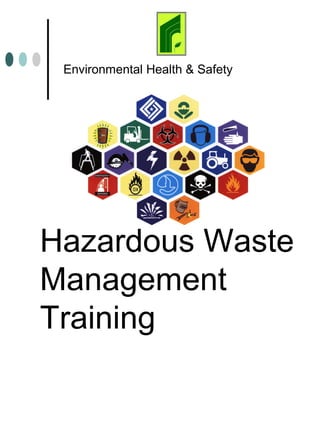This document provides an overview of hazardous waste management training. It defines hazardous waste and outlines the characteristics that cause a waste to be considered hazardous, such as ignitability, corrosivity, reactivity, and toxicity. It discusses how to complete hazardous waste tracking forms and labels, including identifying the waste, quantities, and safety precautions. Regulations around accumulation and storage of hazardous waste on site for 90 days or less are covered, as well as exemptions for satellite accumulation areas where waste can be stored near the point of generation.















![Storage/Satellite
Accumulation
Current hazardous waste regulations,
allows the University to hold
hazardous waste on campus for only
90 days
which is an accomplishable time frame
with everyone working together
this works out to one time each quarter
which is the preferred method that keeps
the University/Colleges from being fined
Exemptions to Storage Regulations –
Satellite Accumulation
Title 22, of the California Code of Regulations,
Section 66262.34 [e] (Satellite Storage Areas)
allows hazardous waste to be accumulated in
containers for longer than 90 days under the
following conditions](https://image.slidesharecdn.com/hazwastetraining-150413134657-conversion-gate01/85/Haz-wastetraining-16-320.jpg)













